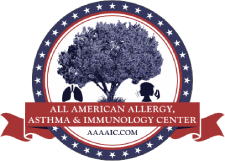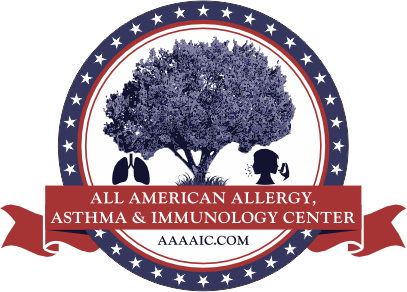Seasonal Allergic Rhinitis:
Background – Seasonal allergic rhinitis, also called hay fever, is triggered by pollen in the air from trees, grass, ragweed, and other plants during different times of the year. It affects 30 to 60 million people in the United States annually, including 10% to 30% of adults and as many as 40% of children. For South Texas, the most immunopotent aeroallergens are Ragweed in Fall, Mountain Cedar or Juniper in Fall/Winter, Oak in Spring and various Grasses (Bahia, Bermuda, Orchard, Sweet Vernal and Timothy) in Summer. The mostly warm climate and significant windy conditions makes South Texas a hotbed for aeroallergens.
How it works/Pathophysiology – Upper airway exposure to pollen that one is allergic to cause the immune system to produce an antibody (IgE). The IgE antibody in turns makes inflammatory cells that line the airways release inflammatory mediators such as Histamine and Leukotrienes. Inflammatory mediators such as Histamine cause the lining of the sinuses and airways to become itchy, produce mucous, and to swell causing stuffiness, congestion and sinus pressure.
Symptoms:
- Sneezing
- Stuffy nose (nasal congestion)
- Sinus pressure
- Runny nose
- Tearing/Red eyes
- Dark circles under the eyes
- Mucus (phlegm) in the throat – this is also called “postnasal drip” or upper airway cough syndrome
- Itchy sinuses, throat, eyes, ears and skin
Self-Treatment Tips:
- Limit your exposure to seasonal allergens
- Check your local pollen counts whenever you check the weather
- Limit outdoor activities during times of high pollen counts
- Wear protective wear such as face masks, eyewear, gaiter, and sleeves/pant
- Wear sunglasses and a wide brim hat to reduce pollen exposure
- Keep windows closed during high pollen and mold seasons
- Steam clean carpets or remove carpets
- Vacuum with a HEPA filter to reduce dust in your home
- Wash your bed linens and pillowcases in hot water and detergent frequently
- Use HEPA Air Purifiers in the house (small size 200 sq ft, medium size 200-400 sq ft, large size 400-1500 sq ft)
- Change out AC filters at least every 2 months
- Change out vehicle air cabin filters every 2 months
- Take over the counter intranasal steroid such as fluticasone or nasocort along with second generation antihistamine such as Xyzal, Zyrtec, Claritin or Allegra.
- For ocular symptoms try otc ophthalmic antihistamine such as pataday or zaditor.
- For sinus pressure and congestion an otc decongestant but for no longer than (3-4) days
For More Natural therapy:
- For sinus pressure and congestion, application of warm damp compress to sinus
- For sinus pressure and congestion, steam inhalation; can also use essential oils such as peppermint or eucalyptus
- For sinus pressure and congestion, application of nasal saline spray
- For sneezing, runny nose and/or itchy sinuses, application of cold compresses to sinus
- For sinus pressure and congestion, topical mentholated ointment such as Vicks vaporub
- For sinus pressure, congestion and inflammation, sinus washes/lavage with Neilmed kit or Neti pot
- For “post nasal drainage” or cough, gurgling with warm salt lemon water
- For eye allergy symptoms, ophthalmic saline solution, cold compresses, aloe vera gel around eyes
Diagnostic Testing – Aeroallergen Skin testing consist of pricking the arms and/or back with up to 48 of the most common aeroallergens in Texas. 20 minutes later, the wheel and flare of the prick site is measured, and the allergy provider will discuss the results and overall interpretation.
In-Vitro Aeroallergen testing consist of whole blood draw at a local lab for which the whole blood is analyzed for the IgE antibody to 48 of the most common aeroallergens in TX. About 1.5 wks later, the allergy provider will discuss the results and overall interpretation.
Nasal Cytology testing consists of a nasal smear which is obtained safely and expediently via nasal swabs from each nasal cavity. It is useful, inexpensive and an easy diagnostic method to better detail the phenotypic characteristics of sinus symptoms. In fact, it allows to detect and quantify the cell population within the nasal mucosa at a given time. The technique involves sampling, processing and microscope reading. Sampling requires the collection of cells from the surface of nasal mucosa that is usually done by sterile swabbing. Samples are collected from the middle portion of the inferior turbinate where the ratio ciliate/mucinous cells is expected to be well balanced. The sample is stained on a slide and viewed/analyzed using optical microscopy with oil detecting the presence of inflammatory elements (eosinophils, mast cells, neutrophils and lymphocytes). Apart from the normal cell population, some specific cytological patterns can be of help in discriminating among various diseases. Viral infections, bacterial infections, allergic rhinitis, vasomotor rhinitis and overlapping forms can be easily identified.
Aeroallergy Immunotherapy (Allergy shots) – Allergy shots or AIT are subcutaneous injections of a small amounts of the specific aeroallergen(s) that you are allergic to. It is just enough to stimulate your immune system in order to desensitize your body over time, which causes your allergy sxs to diminish over time. It is up to 85% effective. Patients who are part of the effective group will first notice improvement within the first 4-8 months of therapy. It will continue to improve. Studies show that most patients will need to be on the maintenance phase of AIT for at least (3-5) years in order to obtain long lasting benefit. AIT is conducted in (2) phases. The buildup phase for routine AIT will require a shot 2 times a week for the first (8) weeks in most cases. The maintenance phase requires an AIT shot once every (2-4) weeks thereafter in most cases. The overall rate of adverse reactions for AIT in most large validated studies is <1%. For patient’s with lifestyle and schedule conflicts we also offer Cluster and Rush buildups, which enables faster time to the maintenance phase in 4 wks or less. Patients must be observed in the clinic for at least (30) minutes after each shot. Allergy shots are administered on a “walk in” basis during normal business hours, so there is no need for an appointment.
Sublingual Aeroallergen Immunotherapy (Allergy tabs) – Treatment typically takes 3-5 years, but can vary based on allergy type and patient adherence. The tablets are small amounts of the specific aeroallergen that you are allergic to. Currently, there are tablets FDA approved just for dust mites, grass (Timothy and 5-grasses), and ragweed. It is just enough to stimulate your immune system in order to desensitize your body over time, which causes your allergy sxs to diminish over time. It is around 70-75% effective. The side effect profile is less than AIT. Pt’s will take the first dose in the clinic and at home thereafter. The tablets for grass are started (12) wks before summer. The tablets are usually taken daily for at least (3) years to obtain a long-lasting effect.
Sublingual Aeroallergen Immunotherapy (Allergy drops) – Allergy drops work like allergy shots by gradually helping your body build tolerance to the antigens or substance(s) that cause your allergies. The difference is that the antigen is placed under your tongue in a pain-free, liquid drop customized to your aero allergy profile. It is also nearly as effective as the shots and are actually safer. This form of immunotherapy is self-administered by patients. It is convenient for patients who don’t like needles, have time to come into the allergy clinic for a shot and or like to manage their own care in the convenience of their home or while traveling. Allergy drops are also very affordable. Please see the pricing tab for more information.
Osteopathic Manipulative Sinus Drainage (OMT) – OMT or sinus effleurage is an manual technique where the lymphatic system of the sinuses are opened and drained using gentle massage. It is used for patients who are actively experiencing sinus congestion or pressure.

Perennial Allergic Rhinitis:
Background – Perennial allergic rhinitis, also called hay fever, is triggered by pollen in the air from trees, grass, ragweed, mold, animals, dust mites and occupational allergens all of which cause symptoms for most days throughout the year. The mostly warm climate and significant winds make South Texas a hotbed for aeroallergens.
How it works/Pathophysiology – Upper airway exposure to pollen that one is allergic to cause the immune system to produce an antibody (IgE). The IgE antibody in turns makes inflammatory cells that line the airways release inflammatory mediators one of which is Histamine. Inflammatory mediators such as Histamine cause the lining of the sinuses and airways to be itchy, produce mucous, and to swell causing stuffiness, congestion and sinus pressure.
Symptoms:
- Sneezing
- Stuffy nose (nasal congestion)
- Sinus pressure
- Runny nose
- Tearing/Red eyes
- Dark circles under the eyes
- Mucus (phlegm) in the throat – this is also called “postnasal drip”
- Itchy sinuses, throat, eyes, ears and skin
Self-Treatment Tips – Limit your exposure to seasonal allergens
- Check your local pollen counts whenever you check the weather
- Limit outdoor activities during times of high pollen counts
- Wear protective wear such as face masks, eyewear, gaiter, and sleeves/pant
- Wear sunglasses and a wide brim hat to reduce pollen exposure
- Keep windows closed during high pollen and mold seasons
- Steam clean carpets or remove carpets
- Vacuum with a HEPA filter to reduce dust in your home
- Wash your bed linens and pillowcases in hot water and detergent frequently
- Use HEPA Air Purifiers in the house (small size 200 sq ft, medium size 200-400 sq ft, large size 400-1500 sq ft)
- Take over the counter intranasal steroid such as fluticasone or nasocort along with second generation antihistamine such as Xyzal, Zyrtec, Claritin or Allegra; For ocular symptoms try otc ophthalmic antihistamine such as pataday or zaditor
- For sinus pressure and congestion an otc decongestant but for no longer than (3-4) days
For More Natural therapy:
- For sinus pressure and congestion, application of warm damp compress to sinus
- For sinus pressure and congestion, steam inhalation; can also use essential oils such as peppermint or eucalyptus
- For sinus pressure and congestion, application of nasal saline spray
- For sneezing, runny nose and/or itchy sinuses, application of cold compresses to sinus
- For sinus pressure and congestion, topical mentholated ointment such as Vicks vaporub
- For sinus pressure, congestion and inflammation, sinus washes/lavage with Neilmed kit or Neti pot
- For “post nasal drainage” or cough, gurgling with warm salt lemon water
- For eye allergy symptoms, ophthalmic saline solution, cold compresses, aloe vera gel around eyes
Diagnostic Testing – Aeroallergen Skin testing consist of pricking the arms and/or back with up to 48 of the most common aeroallergens in Texas. 20 minutes later, the wheel and flare of the prick site is measured and the allergy provider will discuss the results and overall interpretation.
In-Vitro Aeroallergen testing consist of whole blood draw at a local lab for which the whole blood is analyzed for the IgE antibody to 48 of the most common aeroallergens in TX. About 1.5 wks later, the allergy provider will discuss the results and overall interpretation.
Nasal Cytology testing consists of a nasal smear which is obtained safely and expediently via nasal swabs from each nasal cavity. It is useful, inexpensive and an easy diagnostic method to better detail the phenotypic characteristics of sinus symptoms. In fact, it allows to detect and quantify the cell population within the nasal mucosa at a given time. The technique involves sampling, processing and microscope reading. Sampling requires the collection of cells from the surface of nasal mucosa that is usually done by sterile swabbing. Samples are collected from the middle portion of the inferior turbinate where the ratio ciliate/mucinous cells is expected to be well balanced. The sample is stained on a slide and viewed/analyzed using optical microscopy with oil detecting the presence of inflammatory elements (eosinophils, mast cells, neutrophils and lymphocytes). Apart from the normal cell population, some specific cytological patterns can be of help in discriminating among various diseases. Viral infections, bacterial infections, allergic rhinitis, vasomotor rhinitis and overlapping forms can be easily identified.
Aeroallergy Immunotherapy (Allergy shots) – Allergy shots or AIT are subcutaneous injections of a small amounts of the specific aeroallergen(s) that you are allergic to. It is just enough to stimulate your immune system in order to desensitize your body over time, which causes your allergy sxs to diminish over time. It is up to 85% effective. Patients who are part of the effective group will first notice improvement within the first 4-8 months of therapy. It will continue to improve. Studies show that most patients will need to be on the maintenance phase of AIT for at least (3-5) years in order to obtain long lasting benefit. AIT is conducted in (2) phases. The buildup phase for routine AIT will require a shot 2 times a week for the first (8) weeks in most cases. The maintenance phase requires an AIT shot once every (2-4) weeks thereafter in most cases. The overall rate of adverse reactions for AIT in most large validated studies is <1%. For patient’s with lifestyle and schedule conflicts we also offer Cluster and Rush buildups, which enables faster time to the maintenance phase in 4 wks or less. Patients must be observed in the clinic for at least (30) minutes after each shot. Allergy shots are administered on a “walk in” basis during normal business hours, so there is no need for an appointment.
Sublingual Aeroallergen Immunotherapy (Allergy tabs) – Treatment typically takes 3-5 years, but can vary based on allergy type and patient adherence. The tablets are small amounts of the specific aeroallergen that you are allergic to. Currently, there are tablets FDA approved just for dust mites, grass (Timothy and 5-grasses), and ragweed. It is just enough to stimulate your immune system in order to desensitize your body over time, which causes your allergy sxs to diminish over time. It is around 70-75% effective. The side effect profile is less than AIT. Pt’s will take the first dose in the clinic and at home thereafter. The tablets for grass are started (12) wks before summer. The tablets are usually taken daily for at least (3) years to obtain a long-lasting effect.
Sublingual Aeroallergen Immunotherapy (Allergy drops) – Allergy drops work like allergy shots by gradually helping your body build tolerance to the antigens or substance(s) that cause your allergies. The difference is that the antigen is placed under your tongue in a pain-free, liquid drop customized to your aero allergy profile. It is also nearly as effective as the shots and are actually safer. This form of immunotherapy is self-administered by patients. It is convenient for patients who don’t like needles, have time to come into the allergy clinic for a shot and or like to manage their own care in the convenience of their home or while traveling. Allergy drops are also very affordable. Please see the pricing tab for more information.
Osteopathic Manipulative Sinus Drainage (OMT) – OMT or sinus effleurage is an manual technique where the lymphatic system of the sinuses are opened and drained using gentle massage. It is used for patients who are actively experiencing sinus congestion or pressure.
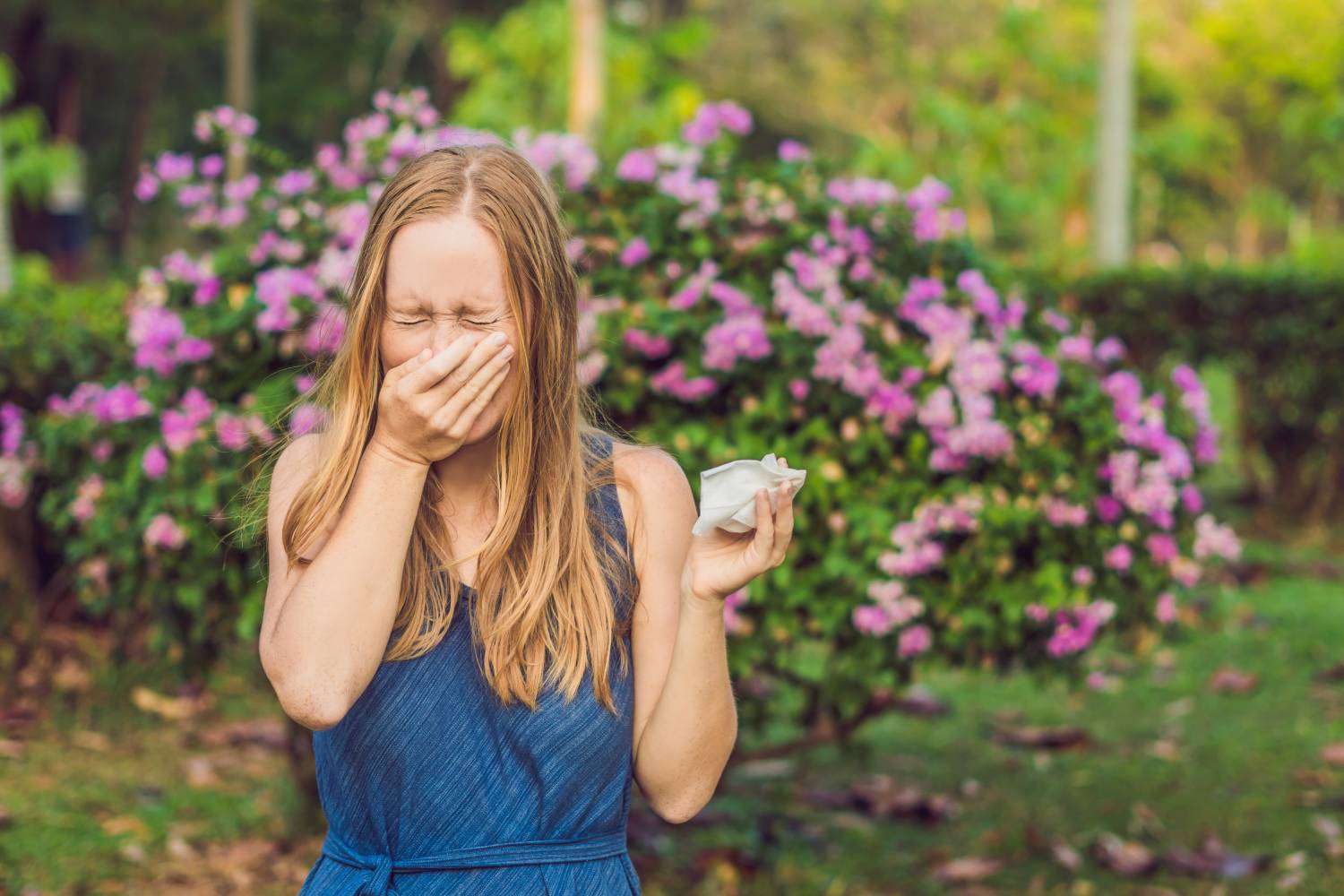
Non-Allergic Rhinitis:
Background – Non Allergic rhinitis is triggered by different elements to include infections, pollen, changes in barometric pressure, temp changes, certain foods/beverages, occupational exposures, medications,8f environmental exposures and anatomical abnormalities (i.e. deviated septum, nasal polyp, nasal spur, atrophic turbinates).
How it works/Pathophysiology – The triggers mentioned above are believed to directly stimulate inflammatory cells that line the airways release inflammatory mediators such as Histamine and Leukotrienes. These mediators such as histamine cause the lining of the sinuses and airways to become itchy, produce mucous, and to swell causing stuffiness, congestion and sinus pressure.
Symptoms:
- Sneezing
- Stuffy nose (nasal congestion)
- Sinus pressure
- Runny nose
- Tearing/Red eyes
- Dark circles under the eyes
- Mucus (phlegm) in the throat – this is also called “postnasal drip” or upper airway cough syndrome
- Itchy sinuses, throat, eyes, ears and skin
Self-Treatment Tips:
- Limit your exposure to the known triggers
- Vacuum with a HEPA filter to reduce dust in your home
- Wash your bed linens and pillowcases in hot water and detergent frequently
- Use HEPA Air Purifiers in the house (small size 200 sq ft, medium size 200-400 sq ft, large size 400-1500 sq ft)
- Take over the counter intranasal steroid such as fluticasone or nasocort along with second generation antihistamine such as Xyzal, Zyrtec, Claritin or Allegra; For ocular symptoms try otc ophthalmic antihistamine such as pataday or zaditor
- For sinus pressure and congestion an otc decongestant but for no longer than (3-4) days
For More Natural therapy:
- For sinus pressure and congestion, application of warm damp compress to sinus
- For sinus pressure and congestion, steam inhalation; can also use essential oils such as peppermint or eucalyptus
- For sinus pressure and congestion, application of nasal saline spray
- For sneezing, runny nose and/or itchy sinuses, application of cold compresses to sinus
- For sinus pressure and congestion, topical mentholated ointment such as Vicks vaporub
- For sinus pressure, congestion and inflammation, sinus washes/lavage with Neilmed kit or Neti pot
- For “post nasal drainage” or cough, gurgling with warm salt lemon water
- For eye allergy symptoms, ophthalmic saline solution, cold compresses, aloe vera gel around eyes
Diagnostic Testing – testing for NAR includes aeroallergen skin testing and or aeroallergen in-vitro testing (see above). It also can include sinus imaging for anatomical abnormalities.

Therapy
Therapy includes the following:
- Antihistamines
- Decongestants
- Nasal corticosteroids
- Leukotriene receptor antagonists
- Cromolyn sodium
- Sinus Lavage
- Sinus Surgery
Osteopathic Manipulative Sinus Drainage (OMT) – OMT or sinus effleurage is an manual technique where the lymphatic system of the sinuses are opened and drained using gentle massage. It is used for patients who are actively experiencing sinus congestion or pressure.
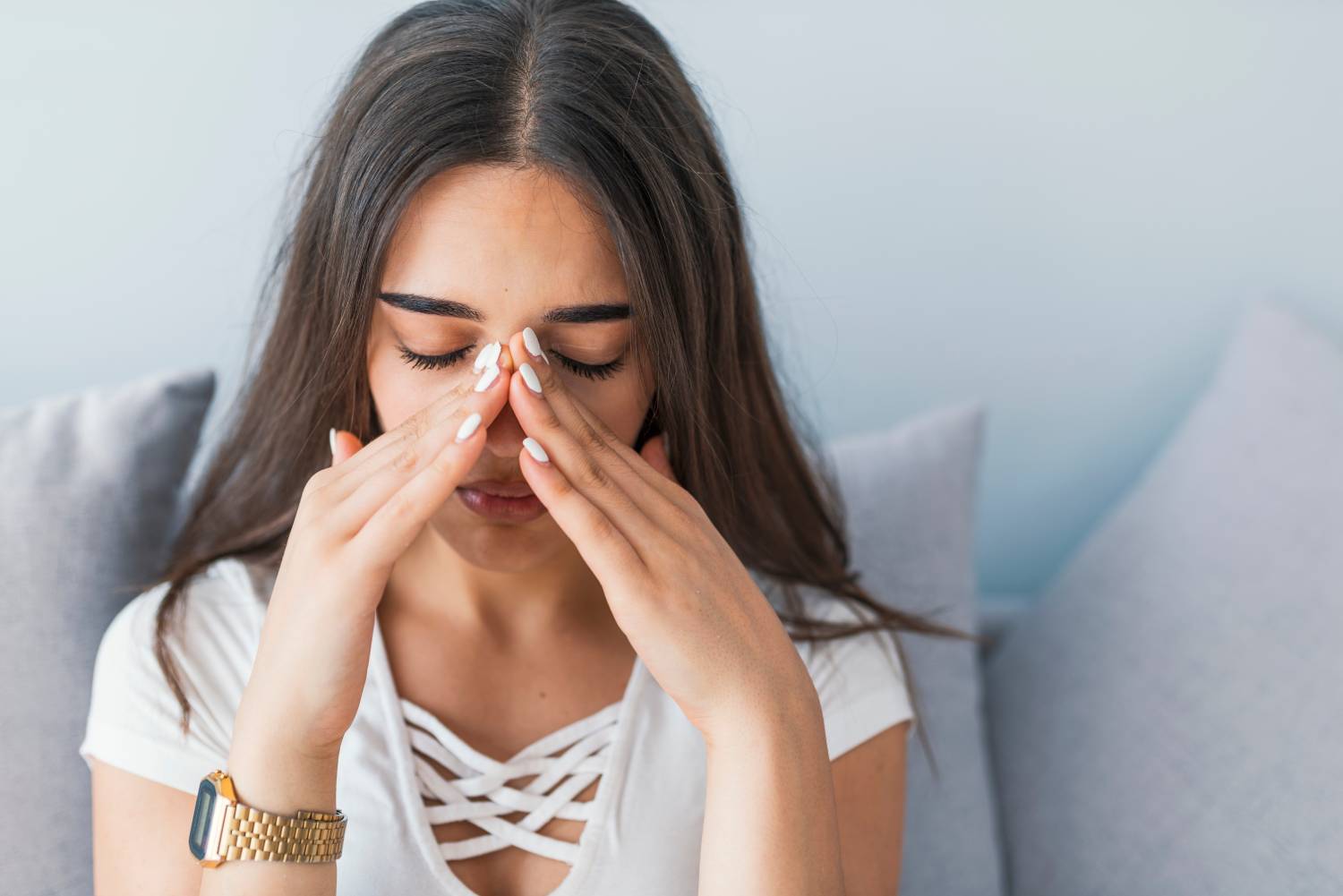
Sinusitis:
Background – sinusitis is an inflammation of the sinuses, the hollow cavities within the cheekbones, around your eyes and behind your nose. It is often caused by a bacterial infection, and may occur following a respiratory infection such as the common cold (viral). When something blocks the mucus in these cavities from draining normally, an infection can occur. People with allergic rhinitis (allergies) or asthma are more likely to suffer from chronic sinusitis because the airways are more likely to become inflamed when allergies or asthma are present.
Acute Sinusitis refers to sinusitis symptoms lasting less than four weeks. Most cases begin as the common cold. Symptoms often go away within a week to 10 days, but in some people, a bacterial infection develops and antibiotics may be required.
Chronic Sinusitis is often diagnosed when acute symptoms have gone on for more than eight weeks despite medical treatment. Some patients with this condition have anatomical abnormalities such as deviated septums, nasal polyps and/or nasal spurs.
Symptoms:
- Thick nasal discharge
- Nasal congestion
- Postnasal drip, often with bad taste
- Cough
- Headache
- Pain in the teeth
- Decreased sense of smell/taste
- Wheeze, if asthmatic
Diagnostic Testing – testing includes aeroallergen skin testing and or aeroallergen in-vitro testing (see above), nasal cytology and sinus imaging for anatomical abnormalities.
Treatment plans can include:
- Sinus irrigation
- Nasal steroid sprays
- Allergen Immunotherapy (shots, drops or tabs)
- Antihistamines/decongestants
- Osteopathic Manipulative Sinus Drainage (OMT)
- Antibiotics
- Monoclonal Antibody Therapy (Dupixent or Xolair for nasal polyps)
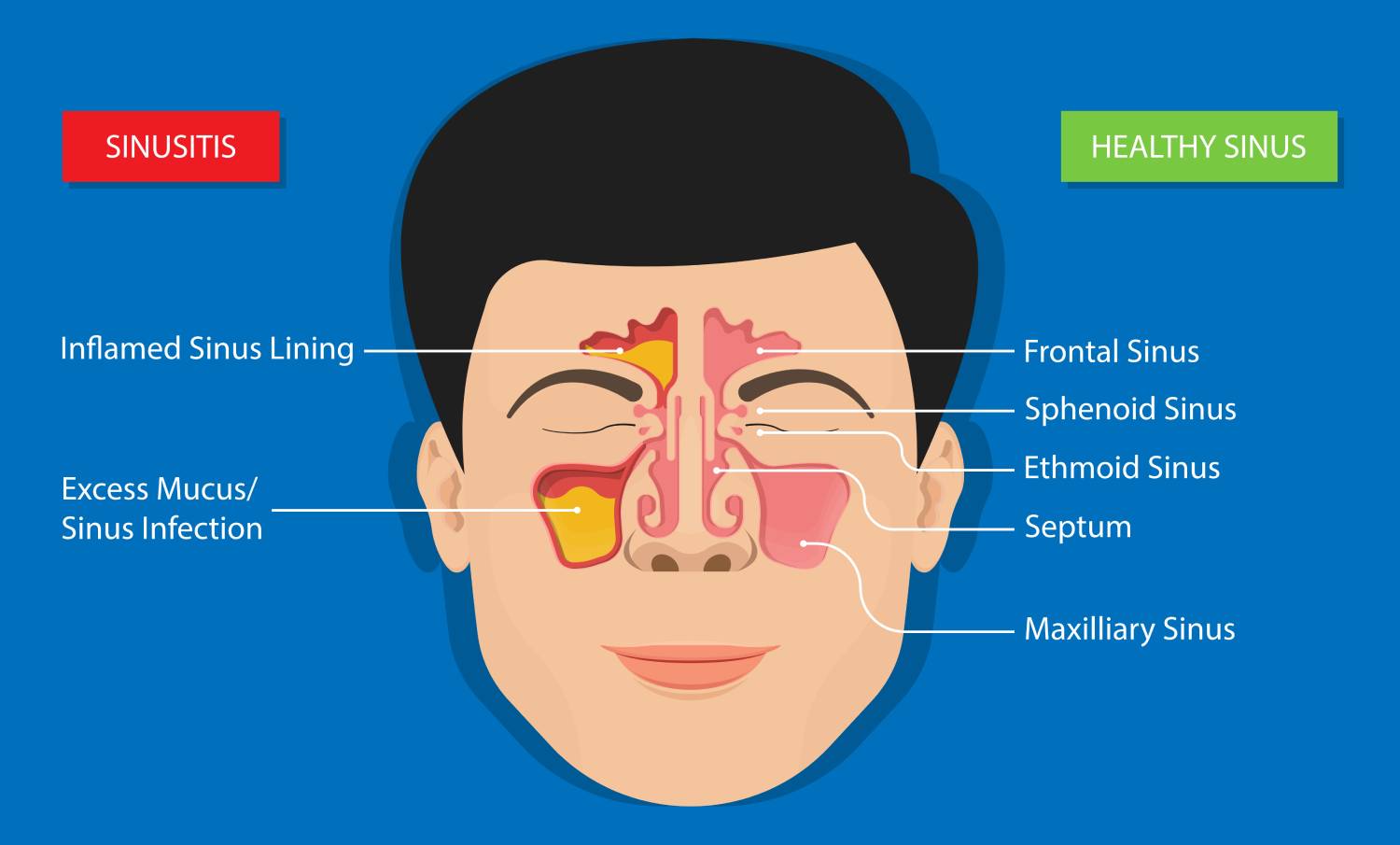
What Happens if Chronic Sinusitis Goes Untreated?
If your chronic sinusitis goes untreated, you can expect frequent sinus, ear and upper and lower respiratory infections. It is even possible for the infection to invade the boney tissue (osteomyelitis), and in rare cases it can cause meningitis. Allergies and chronic sinusitis are responsible for symptoms that make it difficult to enjoy a productive, active life. Don’t let allergies or chronic sinusitis control your life! Work with your allergist to find a solution that helps you take back control and live free of chronic sinusitis.
